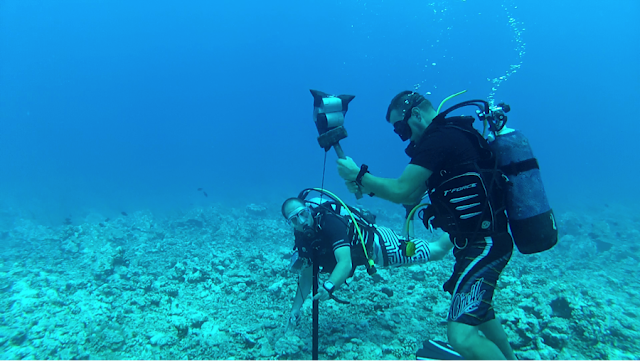October 23, 2103
Today was underwater construction day! We started out with a snorkel in an area near
the shark feeding site. After about half
an hour we had the right spot picked out.
We didn’t want to be right at the shark feeding site, but a ways off. That way we wouldn’t see the effects of a lot
of fish being attracted to bait and have to worry about the effects of the
divers. Instead we wanted to be far
enough away to avoid those effects but still have higher shark abundances than
more “normal” parts of the reef.
We donned our SCUBA gear and descended with three stakes, a
really heavy mallet, and a bag full of the camera housings that we will be
attaching to the stakes tomorrow. It was
a good thing we did that test – one of the housings leaked! But its nothing a bit of silicon can’t
fix! It took us about a half hour to put
the three stakes –spaced several hundred yards apart - in at about 50’ depth. During the dive it was obvious that we were
at a good distance for the work. We saw
at least three blacktip reef sharks – a couple of them individuals that Johann
recognized from his previous work. He
could tell based on their fin markings.
We also saw three female sickle fin lemon sharks. They are quite a bit bigger than the
blacktips and were cruising slowly along the reef slope. One of them had fresh mating scars.
The reefs here on the northern coastline of Moorea aren’t
what you might expect for a remote island in the tropical Pacific. Instead of tons of living coral everywhere,
on the forereef much of the coral is dead.
A combination of a crown-of-thorns starfish outbreak – which resulted in
a lot of coral being eaten – and then a cyclone in 2010 really impacted the
reef. But, everywhere you could see new
corals growing as the reef begins to recover. And, although the coral wasn’t what it will be
once it recovers the fish life was really amazing. We saw what must have been dozens of species
in our short dive.
We had to make a quick trip back to CRIOBE to switch tanks
and to grab our shark-cam that we want to deploy soon. This is our advanced camera that should
get 60 hours or more of video so we need
to make sure that it floats and test how far the VHF signal will go. Of course, we also managed to squeeze in a
nice pasta lunch that Jeremy made…hey, we needed the time between dives!
The second dive was to a site far from shark feeding, but
the same depth, basic reef characteristics, and distance from the lagoon pass
as the shark site. It was another
amazing dive with well over 100’ visibility (I can’t tell you how much over
because I am used to less than 10’)! We
got the three poles in fast and had time for a bit of a tour around the
area. We saw plenty of fish but no
sharks in a similar dive time to this morning.
I can’t wait to get the data from these two sites!
Since we had a little time left in the afternoon we tested
the advanced shark cam – plenty of range on the transmitter and it floats
perfectly! It will be ready to go
tomorrow if we have any luck. However,
we might try our less advanced (and, well less expensive) shark cam tomorrow to
see how it goes. I am excited about a
final modification we made to it so it should get great images and data with no
disturbance to the shark!
 |
| Jeremy doing hammering a stake into a small sand patch in the reef. The bag floating above Johann has the housings for the cameras we will put on the stakes starting tomorrow! |
 |
| Johann's turn. |
 |
| A sicklefin lemon shark cruises through. |
 |
| Mike's turn. |
 |
| Blacktip reef shark. You can identify individuals by the color pattern of their first dorsal fin. |
No comments:
Post a Comment